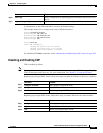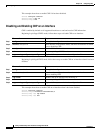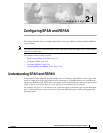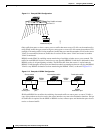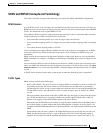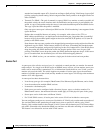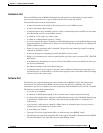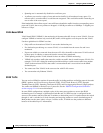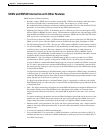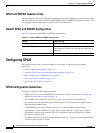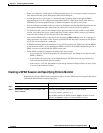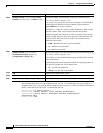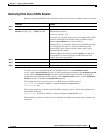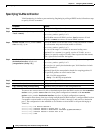
21-5
Catalyst 2950 Desktop Switch Software Configuration Guide
78-14982-01
Chapter 21 Configuring SPAN and RSPAN
Understanding SPAN and RSPAN
Destination Port
Each local SPAN session or RSPAN destination session must have a destination port (also called a
monitoring port) that receives a copy of traffic from the source ports and VLANs.
The destination port has these characteristics:
• It must reside on the same switch as the source port (for a local SPAN session).
• It can be any Ethernet physical port.
• It can participate in only one SPAN session at a time (a destination port in one SPAN session cannot
be a destination port for a second SPAN session).
• It cannot be a source port or a reflector port.
• It cannot be an EtherChannel group or a VLAN.
• It can be a physical port that is assigned to an EtherChannel group, even if the EtherChannel group
has been specified as a SPAN source. The port is removed from the group while it is configured as
a SPAN destination port.
• When it is active, incoming traffic is disabled. The port does not transmit any traffic except that
required for the SPAN session.
• It does not participate in spanning tree while the SPAN session is active.
• When it is a destination port, it does not participate in any of the Layer 2 protocols (STP, VTP, CDP,
DTP, PagP).
• A destination port that belongs to a source VLAN of any SPAN session is excluded from the source
list and is not monitored.
• No address learning occurs on the destination port.
• A destination port receives copies of sent and received traffic for all monitored source ports. If a
destination port is oversubscribed, it could become congested. This could affect traffic forwarding
on one or more of the source ports.
Reflector Port
The reflector port is the mechanism that copies packets onto an RSPAN VLAN. The reflector port
forwards only the traffic from the RSPAN source session with which it is affiliated. Any device
connected to a port set as a reflector port loses connectivity until the RSPAN source session is disabled.
The reflector port has these characteristics:
• It is a port set to loopback.
• It cannot be an EtherChannel group, it does not trunk, and it cannot do protocol filtering.
• It can be a physical port that is assigned to an EtherChannel group, even if the EtherChannel group
is specified as a SPAN source. The port is removed from the group while it is configured as a
reflector port.
• A port used as a reflector port cannot be a SPAN source or destination port, nor can a port be a
reflector port for more than one session at a time.
• It is invisible to all VLANs.
• The native VLAN for looped-back traffic on a reflector port is the RSPAN VLAN.
• The reflector port loops back untagged traffic to the switch. The traffic is then placed on the RSPAN
VLAN and flooded to any trunk ports that carry the RSPAN VLAN.



